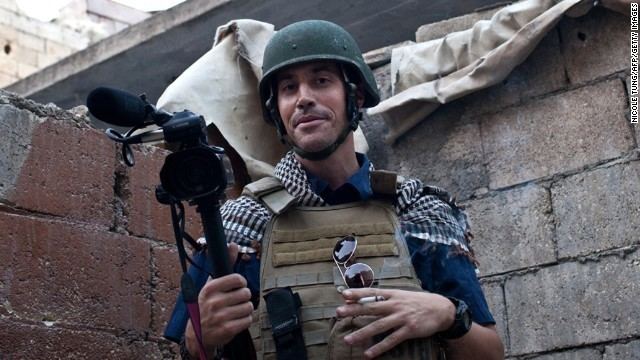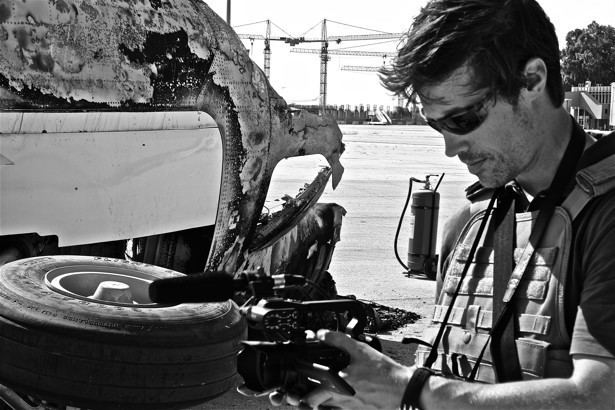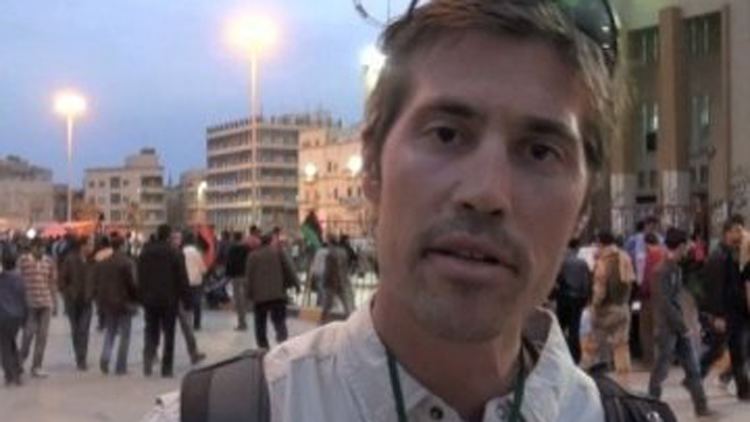Nationality American Parents John Foley, Diane Foley Role Journalist | Name James Foley Occupation Journalist | |
 | ||
Full Name James Wright Foley Cause of death Execution by decapitation Website JamesFoleyFoundation.org Siblings John Foley, Mark Foley, Katie Foley, Michael Foley Similar People Steven Sotloff, Jihadi John, Abdel‑Majed Abdel Bary, David Haines, Alan Henning | ||
Global journalist the life and death of james foley
James Wright Foley (October 18, 1973 – c. August 19, 2014) was an American journalist and video reporter. While working as a freelance war correspondent during the Syrian Civil War, he was abducted on November 22, 2012, in northwestern Syria. He was beheaded in August 2014 purportedly as a response to American airstrikes in Iraq, thus becoming the first American citizen killed by the Islamic State of Iraq and the Levant (ISIL).
Contents
- Global journalist the life and death of james foley
- Early life
- Career
- 2011 detention in Libya
- Kidnapping in Syria hostage negotiations and rescue attempt
- Beheading
- Video
- Legacy
- References
Before he became a journalist, Foley was an instructor for Teach For America. In 2009, he became an embedded journalist with USAID-funded development projects in Iraq, and in 2011 he wrote for the military newspaper Stars and Stripes in Afghanistan, and GlobalPost in Libya. There, he was captured by Gaddafi loyalist forces and held for 44 days. The next year, James Foley was captured in Syria while he was working for Agence France-Presse and GlobalPost.

Early life

Foley was born in Evanston, Illinois, the oldest of five children (John Jr., Mark, Katie, Michael) born to Diane and John Foley of Rochester, New Hampshire. He grew up in Wolfeboro, New Hampshire, where he attended Kingswood Regional High School. He was raised as a Catholic. He graduated from Marquette University, a private, Jesuit Catholic institution, in 1996, from the MFA Program for Poets & Writers at the University of Massachusetts Amherst in 2003, and from Northwestern University's Medill School of Journalism in 2008.
Career

Foley began his career as a teacher in Arizona, Massachusetts, and Illinois for Teach For America (TFA). In the mid-2000s he changed careers to journalism. Starting in 2008, Foley worked for USAID-funded 'Tatweer' development projects in Baghdad. He helped organize conferences and training seminars for a program designed to rebuild Iraq's civil service, crippled by decades of isolation and autocratic administration. In 2010, he left Iraq and applied for military embed-journalist accommodation status in Afghanistan to become a freelance journalist. He was an embedded journalist with US troops in Iraq, where his brother was serving as an officer in the United States Air Force. In January 2011, Foley joined Stars and Stripes as a reporter on assignment in Afghanistan. Two months later he was removed from his post after being detained by US military police at Kandahar Air Field on suspicion of possessing and using marijuana. On March 3, 2011, Foley admitted that he had marijuana in his possession and resigned his position.

In 2011, while working for the Boston-based GlobalPost, Foley went to Libya to cover the uprising against Muammar Gaddafi, embedding himself with rebel fighters.
2011 detention in Libya
According to media reports, on the morning of April 5, 2011, Foley, fellow American Clare Morgana Gillis, a freelance reporter (Atlantic Monthly, Christian Science Monitor, USA Today), as well as Spanish photographer Manu Brabo, were attacked and captured near Brega, Libya, by forces loyal to Gaddafi; fellow photojournalist Anton Hammerl was killed. When the shooting started, Foley and Gillis both heard Hammerl yell out, "Help!" Foley, Gillis, and Brabo were beaten by the pro-Gaddafi forces and then taken as their prisoners. Foley stated: "Once I saw Anton lying there dead, it was like everything had changed. The whole world has changed. I don't even know that I felt some of the blows." Gillis said, "We all glanced down at him as we were being taken by, and I saw him just lying in a pool of blood. And then we were put into the truck and our heads were pushed down. We weren't able to see anything that happened after that to him."
Foley was released from jail 44 days later. On May 18, Foley, Gillis and Brabo, as well as Nigel Chandler (an English journalist also being held), were brought to the Rixos Hotel in Tripoli after release. Foley returned to Milwaukee to thank the community for praying for his safe return. In an interview, he said, "You go through different emotions when you're in captivity... These weird extreme ideas of where you are based on this capture. You don't want to be defined as that guy who got captured in 2011. I believe front line journalism is important [without it] we can't tell the world how bad it might be." Foley also wrote an article for Marquette Magazine about how rosary prayers helped get him through his captivity. His experience of being captured did not deter him; he quickly returned to Libya, and was at the scene of Muammar Gaddafi's capture with GlobalPost correspondent Tracey Shelton on October 20, 2011.
Kidnapping in Syria, hostage negotiations, and rescue attempt
Foley continued working as a freelancer for GlobalPost and other media outlets like Agence France-Presse during the Syrian Civil War. He was kidnapped by an organized gang after departing from an internet café along with his translator and British journalist John Cantlie, in northwestern Syria on their way to the Turkish border on November 22, 2012. Their taxi driver and Foley's translator were not taken. They were reportedly working on a film depicting Cantlie's abduction and dramatic rescue by four members of the Free Syrian Army in July 2012. An Iraqi media outlet reported Cantlie's alleged death on July 28, 2017.
Sources close to the family said that they believed he was kidnapped by Shabiha militia, a group loyal to Syrian President Bashar Assad. He was later reportedly held in a Syrian Air Force Intelligence complex in Damascus.
During negotiations from November to December 2013, Foley's captors demanded 100 million euros in ransom (approximately 132 million US dollars) from Foley's family, GlobalPost (his employer), and the US in exchange for his release. The chief executive officer of GlobalPost, Philip Balboni, stated that the company spent millions on efforts to bring Foley home, including hiring an international security firm, Kroll Inc. In September 2013 the firm was able to locate Foley and track his location. He was moved many times during his captivity. Kroll's research led to GlobalPost reporting that Foley was being held in a Damascus prison run by Syrian Air Force Intelligence, along with at least one other Western journalist, possibly Austin Tice.
In June 2014, Danish photojournalist and fellow hostage Daniel Rye Ottosen was released by ISIS, and called the family to recite a memorized message that came to be known as Foley's final letter. In it, Foley addressed members of his family and described his captivity in a cell with seventeen other hostages, who passed the time with improvised strategy games and lectures. The family released the letter on their Facebook page shortly after Foley's death.
In July 2014, US President Barack Obama authorized a "substantial and complex" rescue operation after the US intelligence community said a "broad collection of intelligence" led to believe that the hostages were being held at a specific location in Syria. However, the mission failed because the hostages had been moved. The operation involved special operations forces from multiple branches of the US military, including the 160th Special Operations Aviation Regiment, helicopters, fixed wing aircraft and drones. When Delta Force commandos landed in the eastern Syrian city of Raqqa, they were met with gunfire and it became apparent that the hostages had been moved. ISIS suffered numerous casualties while American forces suffered a single minor injury. The operation was only de-classified after Foley's death. It represented the first confirmation of US troops operating on the ground within Syria during the Syrian Civil War.
On August 12, 2014, Foley's parents received an email from his captors taking issue with the US government, saying it had refused to pay ransoms, unlike other governments, refused to negotiate prisoner exchanges, and "had no motivation to deal with the Muslims except through force". The email's authors said they had left the US alone since its "disgraceful defeat in Iraq," but would "avenge" the US bombings, initially with the death of Foley. John Foley, the father of James, said he didn't realize how brutal his captors were. Even after receiving the email, he held out hope his son's release could still be negotiated. The family had reportedly been preparing to break US law by offering to pay a ransom for his release. For being an American, Foley was subjected to many mock executions and regular torture, and beatings during his captivity.
Beheading
Foley's whereabouts were unknown to most until August 19, 2014, when ISIS uploaded a video to YouTube entitled "A Message to America". Though quickly deleted, it continued to circulate widely on other Internet sites. Filmed in several takes, the video starts with Obama's announcing the first U.S. airstrikes against ISIS in Iraq. It then cuts to Foley kneeling in the desert next to a masked, black-clad ISIS terrorist, and reading a long message expressing regret. After Foley stops, the executioner condemns the U.S. airstrikes and threatens that any aggression by America "will result in the bloodshed of your people."
The actual beheading takes place in less than ten seconds, although the entire recording uses over four-and-a-half minutes. It does not show the actual moment of Foley's decapitation, unlike previous beheading videos, which typically show the entire act. After Foley's beheaded corpse is shown, his executioner reveals that ISIS is holding another American journalist, Time magazine contributor Steven Joel Sotloff, and that he will be killed if President Obama does not halt air strikes against ISIS. A video showing the beheading of Sotloff was released on September 2, 2014.
The video of the Foley beheading was shot at an unknown desert location, and media sources gave the name Jihadi John to the man (later discovered to be Mohammed Emwazi) who made the threats and spoke with a "Multicultural London English" accent. The video was produced and distributed by Al Hayat Media Center, a media outlet of IS that is under the authority of the IS's official propaganda arm, the Al-Itisam Establishment for Media Production, which targets Western and non-Arabic speaking audiences.
Foley's family confirmed his death on August 19. His mother, Diane Foley, posted on the Free James Foley page on Facebook: "We have never been prouder of our son Jim, he gave his life trying to expose the world to the suffering of the Syrian people".
On August 20, the United States National Security Council confirmed that the video was authentic. An unnamed forensics expert, however, commissioned by The Times (UK) to analyze the video, said, "I think it has been staged. My feeling is that the execution may have happened after the camera was stopped". The Times concluded, "No one is questioning that the photojournalist was beheaded, but camera trickery and slick post-production techniques appear to have been used." Jeff Smith, Associate Director of the CU Denver National Center for Media Forensics said, "What's most interesting is that the actual beheading that takes place in the videos, both of them are staged." Particularly, it was noted that no blood can be seen in the video, even though the knife is drawn across the neck area at least six times.
The US Justice Department is pursuing a criminal investigation into Foley's death, Attorney General Eric Holder announced on August 21: "We will not forget what happened and people will be held accountable, one way or the other". On August 22, fellow hostage Peter Moore, who had been held with Foley before his release, called on their captors to release Foley's body to his family. British analyst Eliot Higgins offered photographic and video forensic evidence that Foley was executed at a spot in the hills south of the Syrian city Raqqa.
In December 2014, ISIS offered to give Foley's headless body to his family in exchange for one million US dollars. The swap would take place at the Turkish-Syrian border, through three Syrian negotiators who demanded the body, with DNA evidence, not be given unless the money is paid first. The negotiators claim the initiative is humane, to help end the family's ordeal. "We seek to gather more information about the subject", said the US State Department; Foley's family did not comment on the story.
Video
In response to the widespread posting, viewing, and commenting on the video depicting Foley's murder, Commissioner of Police of the Metropolis Sir Bernard Hogan-Howe warned "We would like to remind the public that viewing, downloading or disseminating extremist material within the UK may constitute an offence under terrorism legislation." He went on to explain that while viewing the video was technically a crime, his officers would be focused on tracking down those who shared the footage or glorified it. Twitter and YouTube executives also warned objectionable material would be deleted and accounts that posted or spread it blocked.
Legacy
Pope Francis called Foley's family to express his condolences. Foley's brother said he believed the US government could have done more to save James during hostage negotiations, adding he hoped the government would "take another look at our approach to terrorist and hostage negotiation." On September 12, 2014, Foley's family started the James W. Foley Legacy Fund. Its stated purpose is to build a "resource center for families of American hostages", build a "global dialogue on governmental policies in hostage crises" and "support American journalists reporting from conflict zones." It also states a purpose of promoting "quality educational opportunities for urban youth." Former students and colleagues from Lowell elementary (where he taught for three years) have since started a scholarship in his name.
The James Foley Scholarship in the J. William and Mary Diederich College of Communication was established at Marquette University in his honor.
On August 22, 2014, Indian sand artist Sudarsan Pattnaik created a sculpture depicting the face of Foley, made of four tons of sand on the beach of Puri city in the eastern province of Odisha. The sculpture, with a message reading "Don't kill innocents!", drew a sizeable crowd on the beach.
The Boston-based GlobalPost, for which Foley had been a contributor, released a statement saying, "While we continue to send staff correspondents to Syria, we no longer accept freelance work from that war zone." Agence France-Presse (AFP) also released a statement saying that it would "no longer accept work from freelance journalists who travel to places where we ourselves would not venture."
In 2016 the documentary film Jim: The James Foley Story was released, directed by Brian Oakes and distributed by Dogwoof.
English singer Sting wrote and recorded "The Empty Chair", a song about Foley's fate, appearing as the last track on his solo studio album 57th & 9th released in November 2016.
